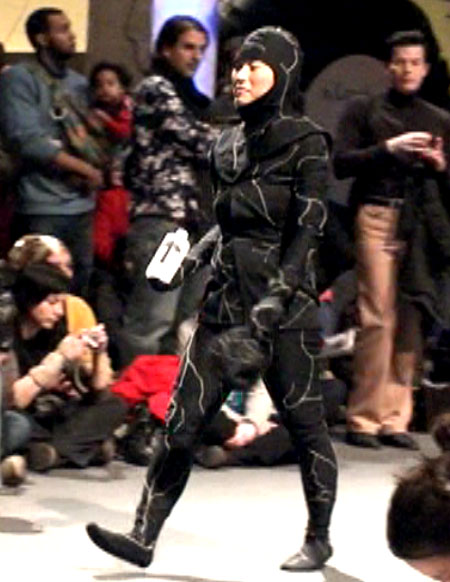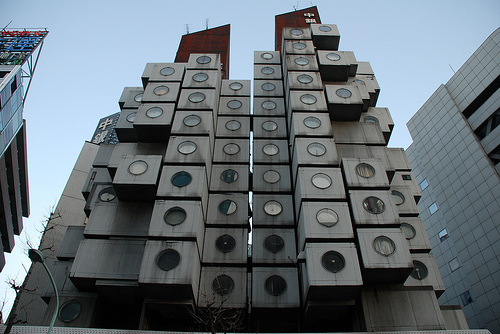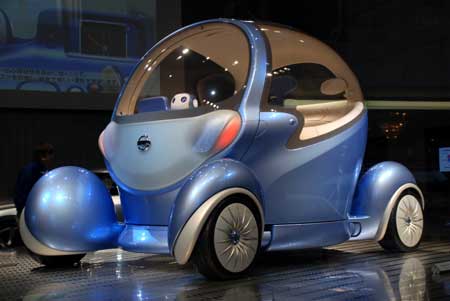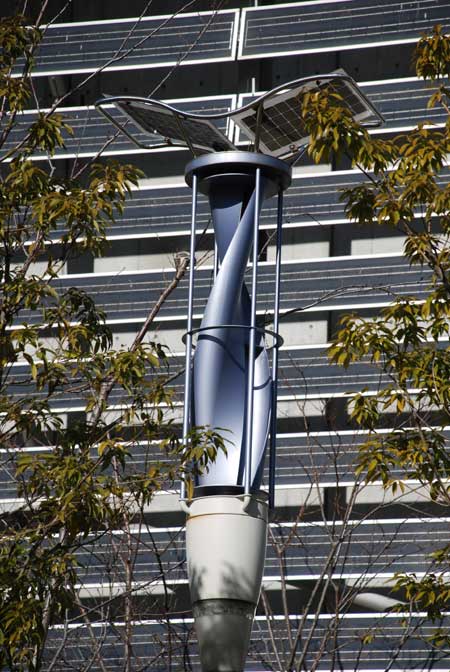joo youn paek showed the polite umbrella at the sigtronica seamless electronic fashion show last week: an umbrella that shrinks when you pull on its handle to make room for passersby. what makes an object polite is not just the fact that it can be considerate of other people, but that you can express empathy by using it in a considerate way (like holding a door open for someone). the polite umbrella is a perfect example of design for conviviality, by allowing a new way of caring – and showing that you care – for other people.
technology for eating alone
when traveling in a foreign country, ordering food can be an adventure. fortunately, japan has a plethora of solutions for avoiding human contact altogether when eating out: the conveyor belt restaurant (above) and the vending machine restaurant (below). in the conveyor belt, a chef prepares small dishes and places them on a conveyor belt that winds through the dining room. seated at a bar in front of the conveyor belt you can pick up any of the small dishes and eat. at the end of your meal the pile of color-coded plates is counted to add up the bill (in modern conveyor belt restaurants, the plates contain an RFID chip which is counted and paid for at an automated kiosk). there’s even a spigot at each seat to dispense hot tea.
in a vending machine restaurant, on the other hand, you pay first by selecting a menu item from a vending machine outside the restaurant. you receive a unique token, and you hand the token to one of the chefs for them to prepare your food. if you want something else, you have to go back outside and get another token.
even though these options exist, i must admit i’ve never tried either one – no matter how hungry or confused – and i’m not sure why. maybe it’s the paradox of eating out alone, or the idea of being fed by a machine. the japanese have a history of finding bits of life that have yet to be automated, and many of these trickle down to other countries. but conveyor belts and vending machines have yet to be seen in restaurants outside of japan – i wonder why?
eco-corpse

jae rhim lee showed the infinity burial suit at the seamless fashion on wednesday: an outfit for an eco-conscious corpse, the suit contains mushroom spores that feed off nutrients created by the decomposing body.
rest in pod

it is still inspiring to see kisho kurokawa‘s nagakin capsule building in ginza, even as the structure falls apart and faces demolition – the building is a monument to an idea, otherwise unlivable, and in all of its ugliness and simplicity reveals more about the way tokyo’s residents actually live than any other building. the metabolist structure represents organic growth and, ironically, decay. unlike moishe safdie’s habitat, the capsule tower has not been maintained by its residents and grows more squalid each year. but the power of the concept might survive its practical use – architects have been fighting to keep the structure alive, probably by replacing the modular and asbestos-filled capsules as the architect originally intended. it was still there last week – so we can sustain the hope that the metabolist ideal survive and for the building to sprout new pods as it always wanted to do.
earring aid
walking through ginza two days ago i saw this window display for hearing aids with an emphasis on fashion: each ear piece can be covered in a variety of different colors and textures to match your outfit or your mood. this has been an ongoing theme in design for the body ever since the human 2.0 conference, in which aimee mullins described the joys of fashionable prosthetics. although her dream legs are still far from the norm, it’s nice to see that hearing aids are joining the ranks of glasses and starting to be presented as fashion accessories.
sociable cookware
recently it’s been theorized that robots are easier to get along with if they have real faces, so what if cookware could do the same? maybe cooking would be more fun, and food might taste better… i spotted a number of sociable pots, pans, cups and bowls in tokyo this week: a sign of things to come?
spinning streetlights
yesterday i stopped by the panasonic center in tokyo and i saw these graceful solar and wind-powered streetlights – so-called ‘seagulls.’ they generate power during the day, storing it in a battery at the base of the light pole, and illuminate at night while continuing to generate wind power. although it seems unlikely that they have a fast energy payback these are add a dynamic design touch that makes them mesmerizing to watch and bring a little festivity into the city:
robot co-pilot

strolling past nissan’s showroom in ginza today i saw an interesting concept reminiscent of the R2D2 + X-wing co-driving model: a ‘future car’ with a robot (similar to papero) embedded in the dashboard as a kind anthropomorphic GPS, a co-pilot, and in any case better than a totally self-driving car because it has a face you can slap. oh, and the car is called the pivot – or pivo2 – because all of the wheels turn independently, blah blah blah…







